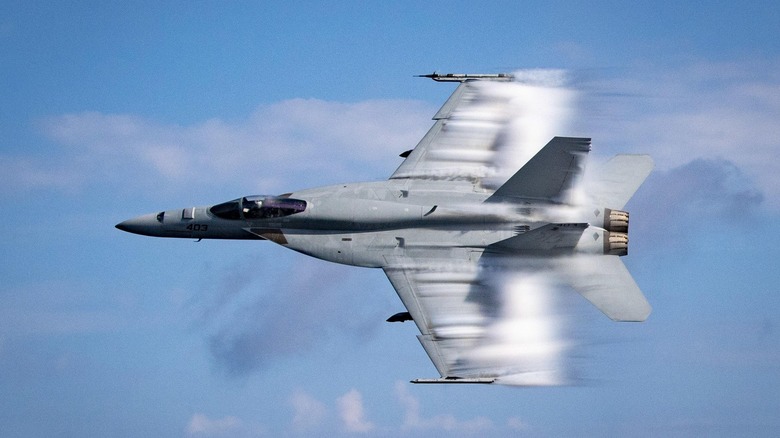Here's How Much An F-18 Super Hornet Jet Actually Costs To Build
In March 2024, the Navy secured a deal that would acquire 17 Block III F/A-18 Super Hornets from Boeing for a grand total $1.1 billion. This purchase will give the Navy 12 F/A-18F and five F/A-18E on top of a technical data package for both Hornet variations and the EA-18G Growler. Rear Adm. John Lemmon, the program executive officer for tactical aircraft at NAVAIR told USNI News, "The technical data package was a crucial part of this negotiation; it is necessary for naval aviation's operational readiness and post-production sustainment." This comes after negotiations stalled in 2023 due to the cost of each individual Super Hornet.
Articles from 1977 released by the US Government Accountability Office state that each individual original F/A-18 Hornet came in at $13 million. If you adjust for inflation, that puts the cost of the current Super Hornet at $72 million, but that's without considering all of the updated technology as well as different materials used for the fuselage. There are a lot of variables that dictate the cost of a product. Estimates from 2023, however, list the naval strike fighter at $55.7 million. It's likely that the real price is higher than that as the original package included 20 Super Hornets, not 17.
The Super Hornet's price tag has been growing
The US Navy and Boeing originally negotiated a similar contract in prior years, but they tabled those talks in 2023 because numbers weren't lining up. The Navy wanted to put $1.15 billion toward 20 F/A-18E/F, but according to USNI News, Boeing calculated the costs rising closer to the price of the fifth generation F-35 Lightning II. Anyone who knows the astronomical cost of the F-35–$102.1 million–knows that's an insane price tag for a plane not nearly as advanced. However, that sounds like the real price tag is close to the aforementioned inflated $72 billion number.
The F-35 has advanced sensors that improve a pilot's situational awareness, requires a special helmet, and provides a level of stealth the Hornet can't even imagine. Nonetheless, the price went up and that kept the Navy from procuring the 20 Super Hornets it originally wanted. Congress wouldn't approve any additional funds to secure those last three fighters. Rep. Rob Wittman (R-Va.), the vice chair of the House Armed Services Committee and chair of the tactical air and land forces subcommittee said, "That contract was for 20 aircraft. It's not going to be 20 aircraft, because we've taken so long to get to a final determination on that contract. The number of dollars will not go as far, but those aircraft need to be built."
The Navy plans to replace the Super Hornet
While the Super Hornet has been in service since 1999, 25 years as of this writing, the Navy intends to keep it as a viable workhorse for another two decades. Rear Adm. John Lemmon said as much in the NAVAIR press release, stating, "The Super Hornet remains a predominant aircraft in the carrier air wing and will continue to provide significant combat capability into the 2040s." However, that doesn't mean the Navy isn't looking ahead because all great things must come to an end. In all likelihood, the Super Hornet, a fourth generation fighter jet, will be replaced by a sixth gen fighter.
Lockheed Martin, Boeing, and Northrop Grumman are all competing for the contract to design the Navy's next-generation fighter that's being referred to as the F/A-XX for the time being. There's no design just yet, just some mock-ups from some of the contractors but on top of a cutting-edge engine, the sixth gen fighter will come equipped with "advanced sensors, advanced lethality, advanced range, and being able to integrate with manned and unmanned capabilities together," Chief of Naval Operations Adm. Lisa Franchetti told Air & Space Forces Magazine. Winner of the contract likely won't be chosen until 2025 sometime.
If all goes according to plan, the Navy could receive and get it in service by the 2030s. Since the Air Force has put its search for a sixth gen fighter on hold due to rising costs, the Navy might end up with one first.


